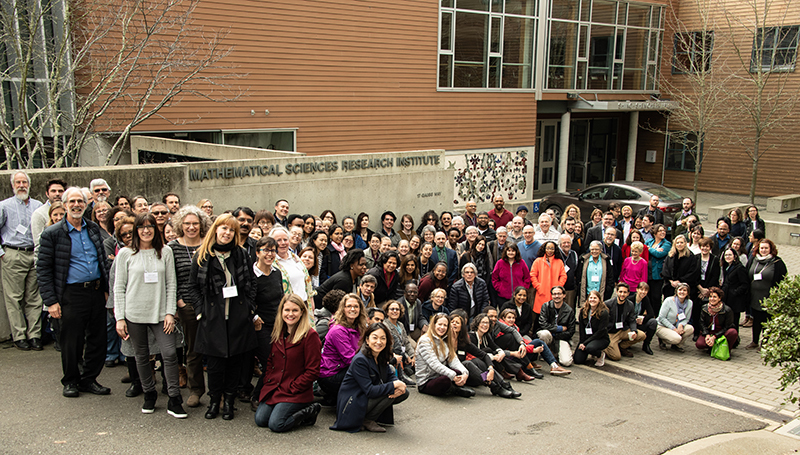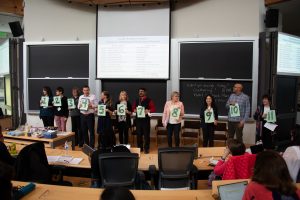Mathematical Modeling (MM) now has increased visibility in the education system and in the public domain. It appears as a content standard for high school mathematics and a mathematical practice standard across the K-12 curriculum (Common Core Standards; and other states’ standards in mathematics education). Job opportunities are increasing in business, industry and government for those trained in the mathematical sciences. Quantitative reasoning is foundational for civic engagement and decision-making for addressing complex social, economic, and technological issues. Therefore, we must take action to support and sustain a significant increase in the teaching and learning of mathematical modeling from Kindergarten through Graduate School.
Mathematical modeling is an iterative process by which mathematical concepts and structures are used to analyze or gain qualitative and quantitative understanding of real world situations. Through modeling students can make genuine mathematical choices and decisions that take into consideration relevant contexts and experiences.
Mathematical modeling can be a vehicle to accomplish multiple pedagogical and mathematical goals. Modeling can be used to introduce new material, solidify student understanding of previously learned concepts, connect the world to the classroom, make concrete the usefulness (maybe even the advantages) of being mathematically proficient, and provide a rich context to promote awareness of issues of equity, socio-political injustices, and cultural relevance in mathematics.
A critical issue in math education is that although mathematical modeling is part of the K-12 curriculum, the great majority of teachers have little experience with mathematical modeling as learners of mathematics or in their teacher preparation. In some cases, mathematics teacher educators have limited experience with mathematical modeling while being largely responsible for preparing future teachers.
Currently, the knowledge in teaching and learning MM is underdeveloped and underexplored. Very few MM resources seem to reach the K-16 classrooms. Collective efforts to build a cohesive curriculum in MM and exploration of effective teaching practices based on research are necessary to make mathematical modeling accessible to teacher educators, teachers and students.
At the undergraduate level, mathematical modeling has traditionally been reserved for university courses for students in STEM majors beyond their sophomore year. Many of these courses introduce models but limit the students’ experience to using models that were developed by others rather than giving students the opportunity to generate their own models as is common in everyday life, in modeling competitions and in industry.
The CIME workshop on MM will bring together mathematicians, teacher educators, K-12 teachers, faculty and people in STEM disciplines. As partners we can address ways to realize mathematical modeling in the K-12 classrooms, teacher preparation, and lower and upper division coursework at universities. The content and pedagogy associated with teaching mathematical modeling needs special attention due to the nature of modeling as a process and as a body of content knowledge.
Overarching critical issue of the 2019 CIME Workshop: How can we individually and collectively advance the teaching and learning of mathematical modeling in K-16?
The following questions will frame the structure of the CIME 2019 Workshop:
1. CRITICALLY EXAMINE CURRENT MM EDUCATIONAL POLICIES AND PRACTICES:
What is the current state of mathematical modeling (MM) education and why isn’t it a central part of mathematics education from K-16?
- What policies bring MM into the curriculum and which have presented obstacles? What has been the impact of Common Core Mathematical Practice Standard 4: Model with mathematics? What is the role of MM with respect to quantitative literacy?
- What curricular resources exist? How do teachers access them? How are they understood by teachers? How are they enacted in classrooms? What is needed?
- Which professional development approaches are effective for teachers?
- How does MM appear in current assessments? How have current assessment development processes and test items supported or created barriers for MM education?
- What current MM teaching practices support equitable classroom environments in which student thinking is valued and respectfully considered?
- How does the way we teach mathematics connect with the workplace?
2. DEVELOP A VISION FOR MATHEMATICAL MODELING EDUCATION:
How can we coordinate and increase efforts to infuse K-16 classrooms with equitable teaching practices through mathematical modeling (MM) education?
- Student Learning in Equitable and Collaborative Environments
How can research inform learning trajectories for math modeling elementary, secondary and undergraduate education? What are key competencies to develop for students to be successful modelers? What are the relationships between mathematical modeling and statistical modeling? How do teachers assess their students’ modeling proficiency?
What are the affordances and challenges of MM with respect to providing a more equitable, just, and humanizing mathematics education? How can MM be taught through effective, equitable and collaborative group work? - Experiential Learning and Community Engagement
How can modeling tasks be tied to community/cultural contexts? How can students use their lived experiences and cultural knowledge along with their mathematical tools and reasoning, to engage in MM? How might MM engage students, especially those who may be marginalized from mathematics? - Policy
How do we convince policymakers and stakeholders of the need for MM in K-16? What are the benefits and challenges of including MM in standards, textbooks and assessments? How might MM be included in state/national teacher certification as a competency/domain? What kind of policy changes would need to happen in order to make MM central in K-16? - Professional Preparation and Development: Teachers, teacher educators, mathematicians
What MM experiences/competencies/support do teachers and teacher educators need to in MM teaching practices and pedagogy? As they teach MM, how can teachers get ongoing support to meet the challenges associated with acquiring mathematical and computational content knowledge as well as contextual information? - Career Preparation and Readiness
How do we position MM as a critical element of workforce preparation in similar ways to computing and engineering? How might we use public awareness of data science (including the positive and negative associations) to help people see the value of MM education? How do we educate policy makers, admissions officers, recruiters, and career counselors about the value of MM in businesses, industry and government agencies?
3. TAKE ACTION BEYOND CIME:
What will you do after the CIME Workshop to contribute to MM in K-16?
- What can mathematicians, mathematics teacher educators, teachers, and professionals in industry do to bring more mathematical modeling into the K-16 classrooms?
- What is the role of each of the constituencies in realizing the vision for mathematical modeling in education?
- How can the mathematics and mathematics education research communities come together to offer solutions?
- What innovative ideas are there to provide professional development to teachers at a global scale?
- How can we use the new Math Modeling Hub platform to create professional communities and resources and sustain these efforts so that they continue to be accessible and useful?

